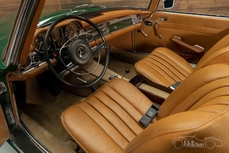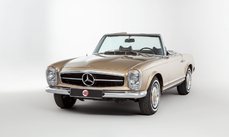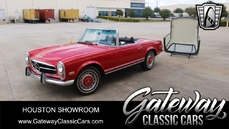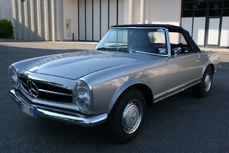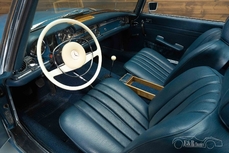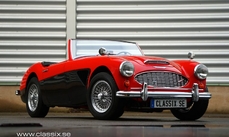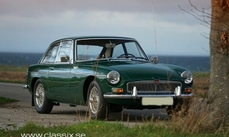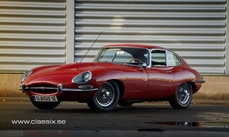Mercedes-Benz 280SL w113 Pagoda with hardtop 1970
General description :
The Mercedes W113 model range consists of 230SL, 250SL and 280SL. These cars were built from 1963 to 1971 and there were about 49,000 cars produced. The biggest rival for this type of car must have been the Jaguar E-type. The W113 was penned by Paul Baracq who was working for Mercedes at the time.
Exterior: Striking looking car in silver with a brown leather interior. It is an older paintwork showing some age in form of stone chips mostly on the doors from getting in and out in a tight garage. Rolling on nice barock wheels and tyres with a thin white stripe. These fill out the wheel arches nicely and make the car look a bit more muscular. The hardtop is in very good condition and underneath is a brand new black soft top. This 280SL has a very nice ride height front and rear. All glass on the car is excellent. Chrome details and panel fit are very good.
The Mercedes W113 280SL Pagoda
Interior: A few years ago a new leather interior was fitted in the original style with perforation in the centre. Carpets look nice and all instruments are in good condition and fully working. There is a wind protector special for the car when you have the top down. In general, this Mercedes 280SL looks very inviting with nice clean door cards, dashboard etc. Seat belts and headrests for your safety.
Engine: The Mercedes 280SL engine bay has just been detailed and painted. The engine looks and sounds perfectly normal and feels strong on the road. The manual gearbox will take you through the four gears smoothly. And being a European model, the rpm is low for a Mercedes from this era. The brakes and other mechanical functions are all normal, giving the driver a safe and solid feel.
History: The Mercedes 280SL was sold new here in Sweden on the 4th of February 1970. It came to the present owner in 2017. A great effort has recently been invested in the car to bring it back to its former glory. The engine bay had a complete makeover and a new soft top was fitted. This is now a very presentable looking Mercedes 280SL Pagoda with manual gearbox looking for a new owner.
We have also a Mercedes 280SL in red here.
Make:Mercedes
Model:280SL Pagoda
Km:76000
Transmission:4-Speed Manual
Manufactured in:Germany
Horsepower/kw:170
Condition:3
https://www.classix.se/classic-cars/mercedes-280sl-pagoda-2/
1970 Mercedes-Benz 280SL w113 Pagoda with hardtop is listed sold on ClassicDigest in Saxtorp by Auto Dealer for €79950.
Car Facts
Car type : Car Make : Mercedes-Benz Model : 280SL w113 Model Version : Pagoda with hardtop Engine size : 0.0 Model Year : 1970 Sub type : Convertible Location : Saxtorp
Sold
Seller Information
Sold
People who viewed this Mercedes-Benz 280SL w113 also viewed similar Mercedes-Benz listed at ClassicDigest
Other cars listed for sale by this dealer
About Mercedes-Benz
In the annals of automotive history, the journey of Mercedes-Benz is a tale that unfolds with the ingenuity of its founding pioneers. In the year 1886, Karl Benz crafted the Benz Patent Motorwagen, a creation that would go down in history as the world's inaugural automobile. Unbeknownst to him, this moment marked the genesis of what would evolve into the most illustrious premium car manufacturer globally. The financial underpinning of this pioneering venture, interestingly, was provided by Karl Benz's wife, Bertha Benz, demonstrating a remarkable partnership that would set the tone for Mercedes-Benz's legacy.A parallel narrative emerged not far away, as Daimler-Motoren-Gesellschaft, founded by Gottlieb Daimler and Wilhelm Maybach, entered the scene. In 1901, they unveiled their automobile under the now-famous moniker "Mercedes," meaning "godsend" in Spanish. This name was bestowed upon the car at the behest of Emil Jellinek's daughter, the distributor for Daimler-Motoren-Gesellschaft. The wheels of innovation were set in motion.
Fast forward to 1926, a pivotal year that witnessed the merger of Daimler with Benz & Cie., culminating in the birth of Daimler-Benz. The amalgamation saw the adoption of "Mercedes-Benz" as the distinguished trademark for their automobiles, fusing the legacies of two visionary entities into one.
Contrary to perceptions of conservatism, the trajectory of Daimler-Benz unfolds as a chronicle of industry firsts. From the introduction of the honeycomb radiator to the float carburetor, and the pioneering implementation of four-wheel brakes in 1924, Daimler-Benz consistently pushed the boundaries of automotive innovation. The diesel-powered Mercedes-Benz 260 D in 1936 marked the inception of diesel engines in passenger cars. The iconic Mercedes-Benz 300SL Gullwing made history as the first car with direct fuel injection, albeit the Gutbrod's tiny 2-stroke engine can claim precedence.
Safety innovations became a hallmark, with Béla Barényi's patented safety cell design in the "Ponton"-models in 1951, featuring front and rear crumple zones. The W116 450SEL 6.9 saw the introduction of the Anti-Lock Brake system (ABS), another pioneering safety feature. From the first production airbags and beyond, the legacy of "firsts" continued to be etched into the fabric of Daimler-Benz.
Over its centennial journey, Mercedes-Benz has not merely produced cars but has sculpted automotive icons. The SSKL, 710 SSK Trossi Roadster, 770K Grosser, 540K Spezial Roadster, 300SL Gullwing, w100 600 Pullman, w111 280SE 3.5 Flachkühler, w113 230SL Pagoda, w109 300 SEL 6.3, and w201 2.3-16 Cosworth stand testament to the brand's commitment to engineering excellence.
The roaring Silver Arrows, or "Silberpfeile," including the W 25, W 125, W154, W165, and W196, created a legacy of dominance on the racetrack. These machines were not merely cars; they were expressions of precision, speed, and an indomitable spirit that left their competitors in the dust.
As Mercedes-Benz marches into the future, it does so not just as an automaker but as a custodian of a legacy, a torchbearer of innovation, and a beacon of automotive excellence. The road ahead is sure to witness the continued fusion of cutting-edge technology, timeless design, and an unwavering commitment to setting new standards in the world of automobiles.
One luminary figure who left an indelible mark was Béla Barényi, often heralded as the "father of passive safety" for his pioneering work in safety engineering. His patented safety cell design, featuring front and rear crumple zones, became a hallmark of Mercedes-Benz's commitment to occupant safety, setting new standards that reverberated throughout the automotive world.
Moving through the chronicles, the collaborative genius of Wilhelm Maybach, alongside Gottlieb Daimler, laid the foundation for Daimler-Motoren-Gesellschaft. Their innovations not only birthed the first Mercedes but established a culture of relentless pursuit of technological excellence that remains integral to Mercedes-Benz's DNA.
In the post-merger era of 1926, Ferdinand Porsche emerged as a prominent figure within Mercedes-Benz. His work on the Mercedes-Benz S-Type, a supercharged race car, garnered acclaim and set the stage for a legacy that extended far beyond the marque. Porsche's impact would later extend to his eponymous company, but his influence at Mercedes-Benz during those formative years was pivotal.
As the 20th century progressed, the legendary Rudolf Uhlenhaut emerged as a key figure. Uhlenhaut, an accomplished engineer and the driving force behind the iconic Silver Arrows, played a crucial role in Mercedes-Benz's dominance in motorsports. His engineering prowess and attention to detail were instrumental in creating some of the most formidable racing cars of the era.
In the latter half of the century, figures like Bruno Sacco, the head of design at Mercedes-Benz from 1975 to 1999, left an indelible imprint on the brand's aesthetic identity. Sacco's design philosophy, characterized by clean lines and timeless elegance, shaped iconic models like the W126 S-Class and the W201 190E, solidifying Mercedes-Benz's reputation for luxury and sophistication.
The narrative would be incomplete without acknowledging the contributions of engineers like Hans Scherenberg, whose leadership in the 1970s ushered in a new era of technological innovation at Mercedes-Benz. Scherenberg's tenure saw the development of groundbreaking technologies, including the Anti-Lock Brake system (ABS) and the introduction of airbags in production cars.
















